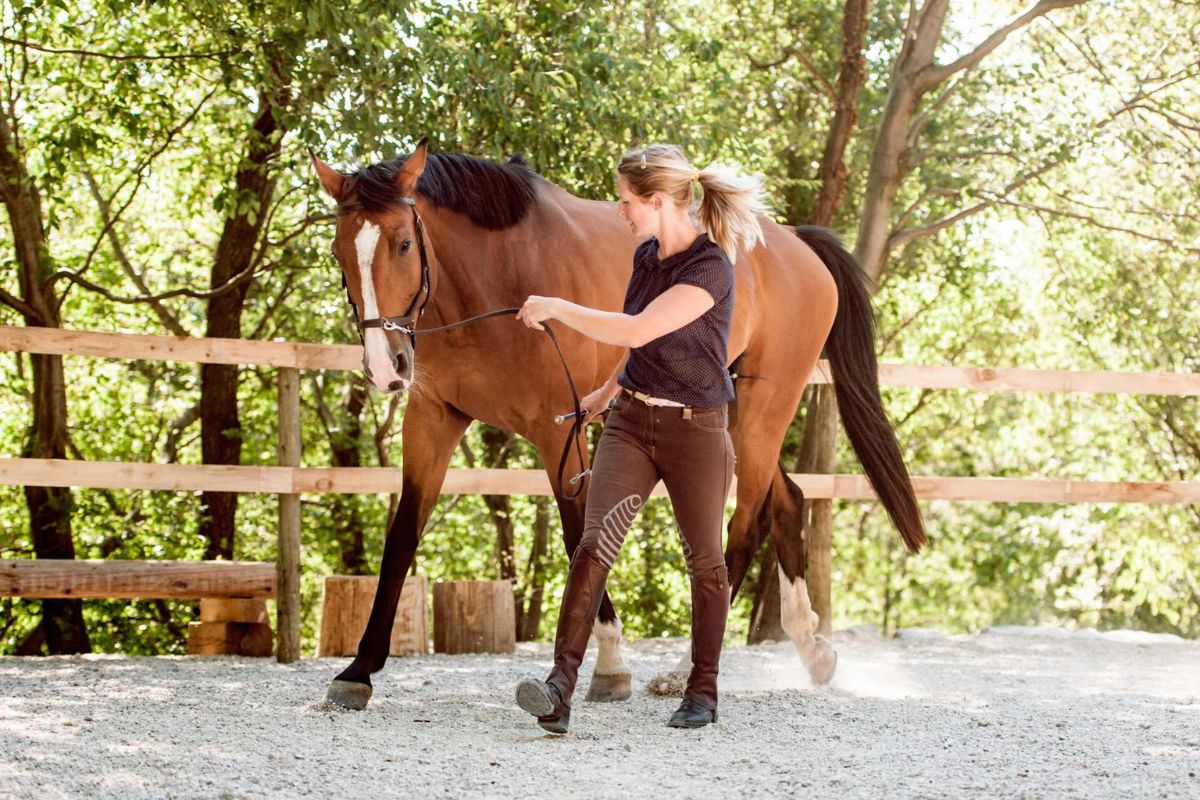Menu

When one lunges their horse, it's essential to be constantly alert to get the most out of it. Just imagine a rider who stands passively in the centre of the riding arena, expecting the horse to exercise itself. That approach won't benefit the team much. Proper longeing is as mentally demanding for the rider as riding itself, and it's crucial to understand this if you want to reap the benefits. So, don't think of a lunge day as a day off for you. Instead, it's a day where you "ride" your horse from the ground, using your voice and body to ensure the horse moves correctly.
PART 2 OF 3
This is the second part of a series on longeing, consisting of three interconnected parts. The first article is titled "Build Up the Horse Rather Than Breaking It Down." The third part is called "Keep an Eye on the Horse's Topline." These articles reflect the experiences of the Malgré Tout editorial team.
When you're not mounted on the horse, you need to communicate differently. Your voice becomes a crucial tool, which, unlike when you're riding, you use to give commands. Everything that your legs and seat usually do must now be taken over by, among other things, your voice.
Always use consistent words for each command, so your horse eventually understands and responds promptly. This consistency will make future longeing sessions much smoother. Whether you say "forward," "trot," or "hop on," every time you want your horse to move into a trot doesn't matter much. The key is not to use the same word when you want the horse to canter. Therefore, you might teach your horse that "trot" means to trot and "canter" means to canter. This way, you can also train it to move directly from a walk to a canter, and you can simply use a command like "forward" when you want the horse to speed up without changing its gait. Of course, teaching this to a horse is more challenging than it sounds, but with consistent use of commands, it's certainly achievable.
The same principle applies to commands that slow down the horse. For instance, if you want your horse to slow down without transitioning to a walk or trot, it's beneficial to use two distinct commands.
Read also: The Comprehensive Guide to Studs – When to Use Which?
You might differentiate between the words "back" and "trot on." Note that the word "trot" here is used differently, as the horse should slow down, introducing a new command. It's also a good idea to elongate the "e" sound, making it "troooteee" and "backeee" and saying it in a deep tone. This approach instills calmness in the horse, helping it understand that the goal is to reduce speed. The horse, of course, doesn't grasp the actual meaning of the words but recognizes the sound's intensity, depth, and rhythm. Therefore, it's especially the tone that one should be mindful of when communicating with the horse using their voice.
The most crucial commands, for which you should find a unique word and appropriate tone, include:
• Move into a walk - e.g., "walk"
• Move into a trot - e.g., "trot"
• Move into a canter - e.g., "canter"
• Slow to a trot - e.g., "troooteee"
• Slow to a walk - e.g., "walkeee"
• Halt - e.g., "hooold"
• Speed up in the current gait - "forward"
• Slow down in the current gait - "back"
Over time, you can undoubtedly teach your horse even more commands. The ones mentioned here are assumed to be the most basic and thus the most crucial to start with.
Your body is also a vital communication tool when working with your horse with a lunge line between you. The significant difference compared to riding is that the lunge line, unlike reins and the rider's seat, can't tell the horse, for instance, to slow down. Along with your voice, you can use your body language on the ground to convey this. By shortening the lunge line slightly, stepping a bit towards the horse, and perhaps extending a hand or whip in front of it, you can signal the horse to halt, especially when combined with the chosen vocal command. In other words, body language can both support and amplify the voice's commands, allowing you, the lunger, to have a more substantial influence, and the horse to understand you better.
Moreover, try to move with the horse rather than standing passively in the centre. It doesn't mean you should run alongside it, but merely move in sync with it. This approach strengthens the bond between you two and makes communication easier because you get closer. One mustn't lose the strong connection with the horse just because they're not riding it.
Read also: 5 Training Tips for Riding the Older Horse
If your horse is comfortable with a lunge whip, you can create a formation where the horse, lunge line, and whip form a triangle with the tip pointing at you. This setup can provide necessary stability, using the whip to encourage the horse forward and the lunge line to hold it back a bit. However, be aware that this makes it harder for you to use your body language and move with your horse around the circle, thus making it more challenging to achieve the closeness that ultimately enhances communication.